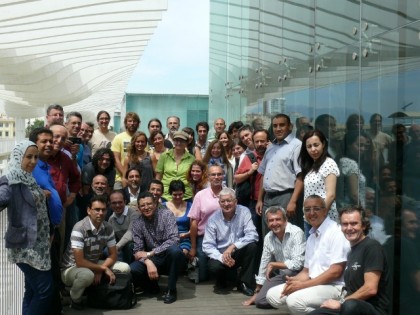
July 2013
 | July 2013 |
Promoting conservation of the Alboran Sea | |
|---|---|
 More than 50 technicians and experts in the conservation of the Alboran Sea, coming from Morocco and Spain, gathered in Malaga from the 19th to the 21rst of June for a Technical Meeting, in the framework of the POCTEFEX-Alboran project. This meeting had been set to analyze the current situation of marine protected areas, cetaceans and marine turtles, integrated coastal zone management and global change in the Alboran Sea. The experts have discussed the main environmental issues affecting this area of the Mediterranean Sea. They agreed the ecosystem approach and the global change context were key elements for the future sustainability of the region. Amongst the identified environmental problems, they highlighted the changes in the use of the environment, intensive coastal occupation, climate change, maritime transport and pollution. Marine protected areas have been identified as potentially multifunctional areas which could provide ecosystemic and socioeconomic services useful for conservation management in the Alboran Sea. Therefore, amongst the actions that are to be implemented jointly by both countries, the experts emphasized the necessity of identifying codes of best practices which would show how an efficient conservation management can contribute to the improvement of the socioeconomic activities of the area. In another workshop of the meeting, the experts gathered information on the research groups and projects of the Alboran Sea related to the conservation status of cetaceans and marine turtles. They brought to light the great volume of available knowledge on this species, particularly on the North coast. They also identified problematic activities which affect them negatively, such as over-fishing, incidental captures, anthropic nuisances and pollution, amongst others. As a joint initiative, the experts proposed the implementation of researches, in particular on the spatial distribution of these species. Finally, they stressed the need to foster collaboration between the stranding networks. This meeting has also enabled exchange of information on the degree of application of integrated coastal zone management models on both coasts, in accordance with the Protocol of the Barcelona Convention ratified by Spain and Morocco. The experts pointed out that integrated coastal zone management is a very useful instrument for coastal governance and that it requires to be reinforced by the politicians in charge. It also needs to benefit from an enhanced visibility in the civil society, especially regarding its benefits for a sustainable management. The objective of this Technical Meeting was to help create the conditions for a work network between experts of both coasts and build the scientific bases necessary for the establishment of technical criteria for the conservation of the Alboran Sea. The event was organized by the IUCN Centre for Mediterranean Cooperation, in collaboration with the Regional Ministry of Agriculture, Fisheries and Environment of Andalusia, Almeria University and the Fishery Department of the Ministry of Agriculture and Maritime Fisheries of Morocco. It was inaugurated by Javier Madrid, the General Director of Environmental Management of the Regional Government of Andalusia, and Antonio Troya, the director of the IUCN Centre for Mediterranean Cooperation. The project Alboran is funded by the Program for Cross-border Cooperation Spain - External Borders (POCTEFEX), a European initiative created to enhance cooperation between Spain and Morocco, with the financial support of the European Fund for Economic and Regional Development (FEDER). The project is coordinated by the Regional Ministry of Agriculture, Fisheries and Environment of Andalusia, in partnership with the Almeria-Centre University for the evaluation and the monitoring of global change, and the IUCN Centre for Mediterranean Cooperation. More info: lourdes.lazaro@iucn.org | |